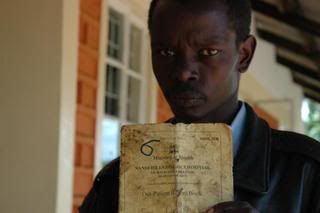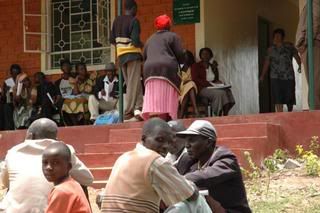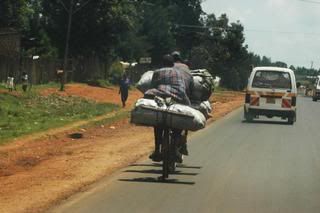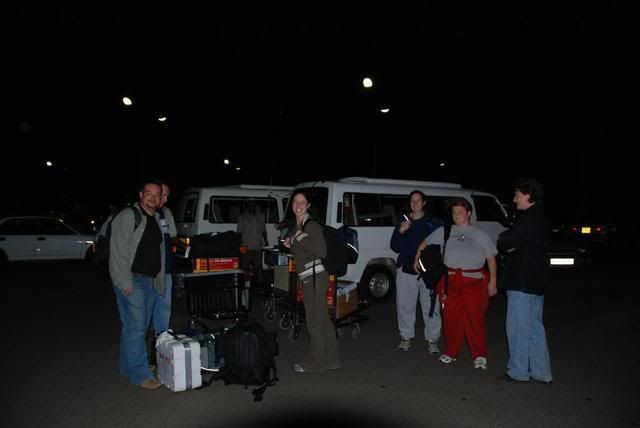no worries, no worries

It takes only a single idea, a single action to move the world!


Hello everyone
Alestar woke up early in the morning to begin his journey. He had been told that eye doctors were visiting the clinic in Kipkaren and his grandmother, his Gogo, had been squinting for months. He pressed his pants the night before, so that he would not waste the morning light. He could hear the rain falling lightly on the metal roof of his small hut and he tucked his pant legs into his socks, so that they would not be muddied and caked in the red clay.
He walked, he took a bus, and he walked a little more. It took him over an hour to reach his Grandmother’s house in Nagong Hills. When he arrived, she was patiently waiting for him. Her small frame draped in a long purple skirt, she wore a black Nike stocking cap to keep the morning cold from her ears. In one hand, she held a knotted wooden cane that supported her like a wise, arthritic finger, her other arm wrapped around her grandson’s youth for support. She was 83, she took very small steps and the journey would be long.
They walked slowly to the bus stop. The bus would be able to take them close to the clinic, but there was still more walking to do when it stopped. Alestar began to worry that they would miss their chance to see the doctors. Heavy rains from the night before had soaked the clay roads into mud and Gogo’s cane kept getting stuck. When the bus dropped them off, Alestar rented a bicycle porter to carry gogo on the back of the bike. Alestar walked beside them to the clinic. At 9 a.m., grandma and grandson were climbing the incline that led to the clinic doors. People were already lined up waiting to be seen, but there were open spaces to sit on the wooden benches. The nurses were not turning people away. Alestar breathed a sigh of relief. His gogo would be treated today.
When it was their turn, he helped her into the clinic and took an old, worn, yellow booklet out of his backpack.  It was his grandmother’s medical history, recorded in Swahili, in no particular order across the pages. “See,” he said pointing to a few penciled markings, “that is where it says blindness.”
It was his grandmother’s medical history, recorded in Swahili, in no particular order across the pages. “See,” he said pointing to a few penciled markings, “that is where it says blindness.”
After the appointment, Alestar stood talking with some of the men that were waiting to be seen, Gogo rested in the grass underneath the shade of the large tree in the front lawn. New gold frames sat on her nose.
A young woman approached her there, as she sat in the grass, and asked her how she was doing. Gogo turned toward the girl and bringing her weathered fingers to her eyes, she touched the golden frames. “This,” she said, tapping the glasses, “This is God.” And a knowing smile crept across her windswept face.

Visiting a dentist or an eye doctor in the city of Eldoret costs the equivalent of $10. A pair of eyeglasses is typically about $45. The average Kenyan, in this area, makes $1/day and an average family can have between 5-12 children. The combination of low income and multiple mouths to feed often relegates medical attention to home remedies. They use blades of grass to remove bugs from their eyes and to relieve an eye infection they squirt the eye with breast milk.
Word had spread about the visiting team of eye doctors and the missionary team told us that we should expect to see many people and that these patients would come from villages near and far. The team was excited to begin treatments on Monday morning.
 The clinic opened at 8 a.m. and when the doctors arrived at 7:30, there was already a line of people, young and old, patiently waiting on the wooden benches outside. The front yard was littered with bicycles. Between 8-5, the optometry team served 135 patients—doling out roughly 120 pairs of glasses.
The clinic opened at 8 a.m. and when the doctors arrived at 7:30, there was already a line of people, young and old, patiently waiting on the wooden benches outside. The front yard was littered with bicycles. Between 8-5, the optometry team served 135 patients—doling out roughly 120 pairs of glasses.
From a rare ocular nerve disease, to untreated diabetes, to debilitating cataracts in the old, to advanced cornea disease in the young, children without eyes, foreign bodies, allergies, to just needing reading glasses, and, sometimes, just needing a little attention. The doctors treated as many patients as they could, as well as they could with the means available. The most striking thing about many of these patients was that their infirmaries, if caught earlier in the U.S., would be completely treatable—cataract surgery, cornea repair, diabetes medication, etc. Here in Kenya, however, these people would go blind.
Michele and Sharon also spent time with Kiptow—the resident nurse for the Kipkaren clinic. Kiptow does everything—delivers babies, treats malaria, administers AIDS tests, diagnoses ringworm, and much, much more. Both Michele and Sharon were amazed by the variety of pathologies presenting at this walk-in clinic on a hill, on a red clay road, through the corn and banana trees.
The Kipkaren Clinic is not a free clinic, but it is affordable to the poor. This is an important change that has occurred between Doc’s visit last year and this week. It costs 50 Kenyan shillings to visit the eye doctor at this clinic. That translates to 76 cents. Medications are not charged by the bottle, but by the number of types of medications that each patient receives: multiple bottles of 1 type of medicine costs 200 schillings ($3), 2 types of medicine 300 schillings ($4.50), reading glasses are 100 shillings, prescription glasses 200 shillings. It is a fraction of the cost of a downtown clinic, but the small cost creates two very important benefits in this Kenyan community. 1) it helps generate capital to sustain the badly needed Kipkaren Clinic, which even though it provided free services in the past, was not free to operate. 2) The Kenyan people may be poor in dollars, but they are rich in dignity. These people are not looking for hand-outs. They were proud to pay for the medicines and glasses. And, by providing a service that they paid for, they were more willing to get involved, have an opinion, select glasses that they liked, that fit well and improved their vision.

Hi Everyone--Thank you for logging on and watching us. Even the best laid plan can be foiled. We started with two computers andf now we are down to one and a few technical difficulties. This will be our last offical day of clinic we have seen well in to 200 patients in two days. We have seen my maladies--it has been very interesting to say the least. Thgis blog will continue to tell the story of our trip and the many things that still need to be done. So even when these dates of this trip are over we will continue to blog on and give updates. Thanks to everyone who made this possible in every way. Thanks Dr. DeAnn Fitzgerald




When the EyeCare Kenya team arrived at the clinic, the people of Kipkarin had already encircled the clinic and they were singing and clapping. David called Doc into the center of the circle and unveiled a hole in the ground and a tree. The type of the tree escapes me, but the story behind the tree is that it is the hardiest tree in Kenya, it is also the most expensive, and it is actually illegal to cut these trees down. “The tree will stand forever,” said David, “So years from now you can bring your children here to see it, your grandchildren, even your great-grandchildren to see the tree that you planted that stands in front of the clinic that you built.”
Doc planted the tree with Julius, the man responsible for running the eyecare clinic day-in and day-out after she leaves.
In Kenya, the power of the elders is highly regarded. So, David asked the Grandfather of the family from Cedar Rapids to anoint the clinic. He poured blessed oil in front of the doorstep and said a beautiful prayer for healing.
With that, a plaque honoring Dr. DeAnn Fitzgerald was unveiled to grace the entryway.
This clinic was dedicated to the glory of God by
Dr. DeAnn Fitzgerald on September 30, 2007.
We treat. God heals.
A piece of twine was stung across the doorway to this clinic, just as it had been strung across the entryway to Kipkaren one day earlier. Doc cut the fraying rope and took the last step of the Kipkaren destination. The clinic was open. It was time for treatment to begin.
Sunday morning started with a first, slightly late, attempt to catch a Kenyan sunrise. Then there was French press Kenyan coffee and a bird-watching, photo shoot on the Kipkaren river. 
“Sundays in Kipkarin are spent in church,” David the director of the entire ELI Kipkaren development explained. “Here we do not understand the concept of weekends or holidays. But on Sundays, we thank God for all that he has given us and we pray to God, because he is our Father and we should tell him how we are doing.”
At 10:00, the team joined the community at church in the ELI compound. We sat in the back of this cafeteria/classroom/church, just soaking it all in. We watched two boys that couldn’t be more than four walk in, one with his nose running and crusty. They walked up to two girls—one of the girls was one of the assistant parents at the orphanage. The girls immediately scooped the boys up onto their laps and cleaned up the runny nose of the one. About a half-an-hour later, the girl was taking the long-sleeved shirt off of the boy with the runny nose. Sharon turns to Michele and says, “I think this little boy might be sick.”
“I know,” replied Michele quickly, she had obviously been thinking the same thing, “I brought 25 digital thermometers with me. I can’t wait to see him tomorrow!”
Then David addressed the congregation. “You do not appreciate your eyes until they are infected,” he began. Then he told the story of Jesus curing the blind man. After the story, he said, “This week Jesus is passing the community in the form of these eye doctors and he wants to visit with the people that are having trouble with sight.”
He then told a personal story. “One year ago, I was visiting at my sister’s house. We were talking and suddenly we heard her daughter, my niece, cry out like a baby in a great amount of pain. When we ran to where the child was, we found that she had dumped hot water all over herself.” David described how he scooped up his niece and took her to one doctor’s house, but the doctor was unable to see her. So he and his sister carried the girl to a nurse’s house, but she would not help the girl, because she was in the middle of fixing dinner for her parents. As David continued walking with his niece in his arms, it began to rain. Her skin turned to blisters and the blisters were rubbed and broken from the journey.
In that moment, David decided, through God’s guidance, to create a more compelling future for himself, his family and his community “ You can’t control the events of your life but you can control what they mean to you.” Ultimately, it is the internal struggle we will all face many times, that David faced that night—to be a victim of experience or to be empowered through experience. To find a higher purpose—a compelling vision.
David said that night that he stood in the middle of the mud roads, in the rain, and asked God for a clinic that he could take his niece to. He would be empowered to make his world a better place. One year later, on this day, they were opening the addition to the clinic that would serve as a general medicine and optometry wing. Proof again that a single idea, a single action, can move the world.
“Now we are going to open the clinic,” he told his group. “I want the choir to pick a song, a lively song. I want the people to sing and dance and show God how much we thank him for answering our prayers. Now everyone, let’s go to the clinic.”A few minutes later, you could see a line of people in bright colored clothes winding their way across the river, around the corn field, through the banana trees, and up the hill, headed toward the new clinic, singing and dancing as they walked.

On Saturday afternoon, the EyeCare Kenya team was invited to join a Birthday celebration for 33 of the kids in the orphanage. Since many of these children were orphaned and found, many of their birthdates are unknown. So ELI picks three days per year to celebrate birthdays. For the celebration, the entire orphanage gathers together. They sing and they dance and have cake and candy. (They have candy in Kenya that is, I believe, called Milk Candy. It is a white sucker that tastes like very sweet milk.)
Empowering Lives International (ELI) is an international organization that essentially works to elevate the standard of living for people around the world through education that focuses on how to best use readily available resources. It very much embodies the, “Teach a man to fish” motto, with a strong undercurrent of spiritual faith and hope. In Kenya, ELI has at least two locations, one at Ilula and one at Kipcarin. Last year, the EyeCare Kenya team visited both locations, but this year, the goal is to finish equipping the eyecare clinic that was recently built in Kipkaren.
Just as there are many immediate needs of this community, there are many services provided by ELI.
Imagine an Iowa farming town where the roads have been created only by back and forth travel that has worn the grass away. Now imagine that Iowa town at an elevation of 6,000 feet, set amongst rolling hills and rivers and banana trees, on a bed of red clay. That is Kipkaren. About forty-five minutes outside of Eldoret, the van turned off of the one major road that links Kenya to Uganda and the team bounced along for a few miles before the caravan finally pulled into the mouth of the driveway of the ELI compound. As we all hopped out of the cars, we could hear singing. When we walked around the corner of the dirt parking lot, it was filled with children 4-10, teachers, staff missionaries, and the ELI administrators standing in a large U. A flower-adorned piece of twine had been strung from one end of the driveway to the other, the final thing standing between EyeCare Kenya and the people we came to help.

We were then officially welcomed to Kipkaren. The director of ELI, the director of the school, and the pastor at ELI each made very touching speeches welcoming us to their home.
They handed DeAnn scissors for her to cut the twine. After the finish line fell, we followed Doc in single file, shaking hands with every child, volunteer, and administrator on the compound. Some of those little kids have very powerful grips.

Hello Everyone! Sorry about the delay in blogs, we were experiencing some technical difficulties, which I guess was to be expected because, hey, we're in Kenya. So you will see many new postings today, because we are operating on all 6 cylinders here again, which in Kenya is akin to being back up on the bicycle. Happy reading...
In Nairobi, the team stayed at a place called the Mayfield House (pictured on the left). The Mayfield House is a missionary guest house set in the northern suburbs of Nairobi. Many missionaries stay here before trekking out to their various posts throughout Kenya. At the same time that EyeCare Kenya team was there, we met a team of ministers from North Carolina, a religious group from South Africa, and another family from Cedar Rapids who had come to Kenya to visit their two daughters that were interning at the ELI compound where the EyeCare Kenya team would also be staying.
Mayfield House was a lot like a sorority house…lots of couches in a few large common areas, a kitchen, large dining hall, dorm rooms with bunk beds and mosquito nets, flushing toilets, HOT showers, and temperamental email access. Sharon is modeling one of the lovely mosquito nets below.
We arrived to Mayfield House around midnight on Friday night, got up early the next morning, had breakfast—chai tea, bananas, peanut butter and honey, and cereal. Loaded the van and left for a small commuter airport in Nairobi, to board a prop-like plane that would take us to Eldoret.
Driving through Nairobi in the daylight was a very different experience. We passed a parking lot filled with people and short buses—about the size of hotel transport vans—that had wooden coffins tied to their roofs. (In Kenya, when family members die in the hospital, the remaining family must pool their money to buy back their beloved family member, so they can provide a proper wake and burial. That burial, incidentally, often takes place in the family’s yard.)
When we had all loaded onto the plane, the pilot turned around and gave us the safety speech usually reserved for American Airline stewardesses—emergency exits and all. Even though it was the same speech we had each heard a million times, I can tell you that when the pilot is pointing out the nearest exits, everyone pays attention. It was a smooth 40 minute flight—a hop, skip, and a jump from Nairobi to Eldoret.
Once we landed, we still had to travel about an hour-and-a-half to the ELI compound in Kipkaren, so we hopped into a van and set-off, yet again. A few sights to mention from the road:

The van stopped in downtown Eldoret in order to pick up half of the Cedar Rapids family that had made it out on the first flight from Nairobi to Eldoret earlier that Saturday morning. The second half had landed with us.
Downtown Eldoret (pictured below) looked a lot like how I have always imagined Tijuana would look except instead of run down lime green and piñata pink stucco buildings set to salsa music, Eldoret was decorated in turquoise, purple, and red mud walls and dilapidated wooden structures squeezed so closely together it felt like the town was holding its breath.

We, however, were not waiting, and quickly jumped back into the vans to continue on to our final destination: Kipkaren.
Good Morning All
HELLO -
(Picking up where we last left off...we had just left the Nairobi airport)

Tonight we landed in Nairobi. The full moon looked so bright and so close—nearly twice as big as the largest full moon I have ever seen from the Mid-West. Oddly enough, the Kenya airport looked more familiar than the moon. It was just slightly bigger than the Des Moines airport. The planes looked the same, except they had names like Kenya Air instead of Delta or Southwest.
At the baggage claim, we were met by Adele, our liason between the village of Eldoret and Kipcaren. She has a rich South African accent and short curly brown hair. A native South African, she has lived in Kenya for two years, and she immediately began showing us the ropes. For example, the baggage claim carts that must be rented in many American airports, are free here, but there is a trick. In order to get the wheels to rotate, you must push the cart handle (similar to a shopping cart) down. She pointed this out as Michele and I were dragging our stuck-wheeled carts across the tile floor, immediately revealing that we were not native Nairobians.
Out of the 29 bags and boxes that were shipped, 28 arrived. The missing box contains sutures and sterilizing drapes—so we have made it here with practically all of the supplies we unloaded in Cedar Rapids. In the Kenya airport, you cannot leave the airport to load a few things and return to grab more from the baggage claim area, once you’ve left the building, you’re out. So the seven of us, 6 on the Kenya team and Adele, packed all 29 bags on 7 of those small luggage carts and headed toward the man Doc has been having nightmares about since her last Kenya adventure…her nemisis, the Customs man. She actually journaled 12 pages of attack and counterattack strategies before stepping off of the plane tonight.
Just to recap, last year she spent 2.5 hours haggling with the Customs man. He wanted money. She was unwilling to bribe. And there they stood, deadlocked. Their conversation last year went:
“Tell me what these supplies and medicines are worth in your country,” he said. (Visitors bringing materials into Kenya, through customs, are required to pay a fee based on the value of what they are bringing in.)
“Nothing. They have all been donated,” she replied.
“Oh, I don’t believe that. Come on, what are they worth?” And so they went. Round and round. When finally she said, “All of these supplies are here to help your fellow Kenyans. If you do not let them in, you’re people will not get the medicines they need.”
And with that he said, “You should have said the supplies were for doctors’ personal use.” Then he paused. “O.k. You may pass.”
Doc and team stood there for a few seconds—probably from surprise—and so he said, “What are you still doing here? I said you can go. Go.”
This year, with 7 packed carts in tow, she walked directly up to the man in the gray suit.
“What are all these supplies for?” he asked.
Doc bowed her head and said, “Doctors’ personal use.”
“You may pass,” said the Custom’s man. So we ran with our medicines out through the airport doors and into the air of Nairobi.
The air had a metalic twinge, as if the breeze had been sucking on a spoon or a penny. We stood there, many of us smelling Kenya for the first time, as our things were loaded into three vans by Adele’s team. We all piled into one van and took off for the place we would sleep for the night.